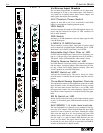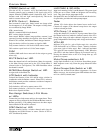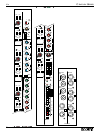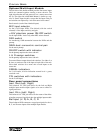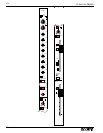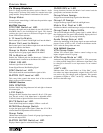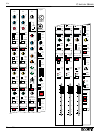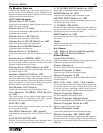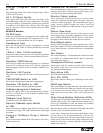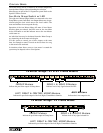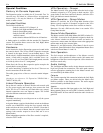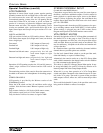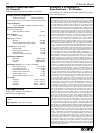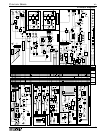
VX
PAGE 22
CENTURY SERIES
Stereo Program SOLO Switch
w/LED
Solo monitoring facility for the Stereo Program signal. Choice
of PFL or AFL in stereo.
Alt L/R Output facility
Stereo output with level control and mute. The source is the
main L&R output, either pre or post output faders. The Mono
mix may be added, it is automatically sourced pre or post fader
in response to the L&R Pre-Post selection. The ALT output
may be operated in Mono when required using the SUM
MONO switch.
MASTER Module
TB MIC Input
Allows for a microphone to be plugged in for use with the talk-
back system. Accepts balanced low impedance mics. +48V
phantom power is provided. Refer also to User Options.
Headphone Jack
Stereo 1/4" TRS socket for all types of headphones. A second
HP socket and TB socket are located beneath the front hand
rest.
10kHz/1kHz/100Hz switches
These push buttons select the sine wave frequency generated
by the internal Oscillator. Lowest selected frequency takes pri-
ority.
Oscillator FREQ Control
This rotary pot adjusts the selected frequency by a minimum
factor of 0.2 or maximum factor of 2.0. Used in conjunction
with the frequency buttons, tones from 20Hz to 20kHz can be
generated.
Oscillator LEV Control
This rotary fader adjusts the Oscillator level between off and
+4dB.
PINK NOISE Switch w/LED
This switches the generator to pink noise replacing tone.
Oscillator ON Switch w/LED
Turns on the internal oscillator / pink noise generator.
Talkback Assignment Switches
Assigns the TB/Osc audio to the summing buses for Mono,
L,R, Aux 1-8 and Groups 1-8. TB to Matrix is enabled locally
at each Matrix section.
Talkback Level Control
Controls the level of the TB/Osc audio.
External Talkback Input Switch
w/LED
Selects the External Talkback Input XLR and adds it to the
local mic or tone signal. The XLR is balanced and accepts high
level audio.
External Talkback Output Switch
w/LED
Turns on the external talkback XLR. The output is local mic or
tone but not Ext mic.
Talkback On/Off Switch
Turns the talkback/osc output on and off. Press+hold for short
message; press+release to lock on, press+release again to lock
off. Controls all routes including TB to Matrix.
Monitor Output system
Stereo monitoring system with main Level control, Mute
switch and outputs on balanced XLRs. The audio sources are
L+R mix or Stereo Tape Input. The Center/Mono mix may be
added. Normally SOLO interupts the source. The SUM
MONO switch combines the L&R monitor audio into a mono
output.
Stereo Tape Input
The stereo audio from the rear panel jacks connects to the
source select switch. If nothing is plugged into these sockets
then STEREO PROGRAM INPUT audio is normallised
through the switch contacts and reaches the source selector.
Solo Defeat switch
Prevents SOLO interupting the normal monitor audio. Allows
the monitor output to be used as an additional dedicated output
circuit when necessary. Included with main and headphone
sections.
Dim Switch
This switch introduces a -12 dB attenuation into the local mon-
itor outputs. It is disabled when SOLO defeat is depressed,
auto-active when TB is on.
Headphone Monitor system
Stereo output, with two sockets in parallel, and level control.
The sources are the same as for the main monitor circuit and
may be selected independantly.
Solo Active LED
This LED indicates that SOLO is active.
AFL/PFL LED's
These LED's indicate which type of SOLOing has been select-
ed.
SOLO type Switch
This switch changes solo type from PFL (Pre-Fader Listen) to
AFL (After-Fader-Listen). Both are available from the majori-
ty of sections in the console. Both are stereo capable. This
switch choses one or the other. AFL is after fader, pan and
mute.
Mute Group Master Switches+LEDs
All Input channels, including Stereo Inputs are connected with
the Mute Group system. Four switches on each channel may be
used in any combination to select the channel onto the Mute
buses. LEDs on the channels show the selection.
When the Master switch is selected the LED lights and the bus
becomes active. All channels on the bus mute.
At any time a channel may be deselected from the bus. If the
bus was active it will un-mute immediately. If the bus was
inactive the channel mute will not change. When a channel is
already locally muted then the mute group confirms the mute.
When the local mute is released then the channel remains
muted by the mute bus.



